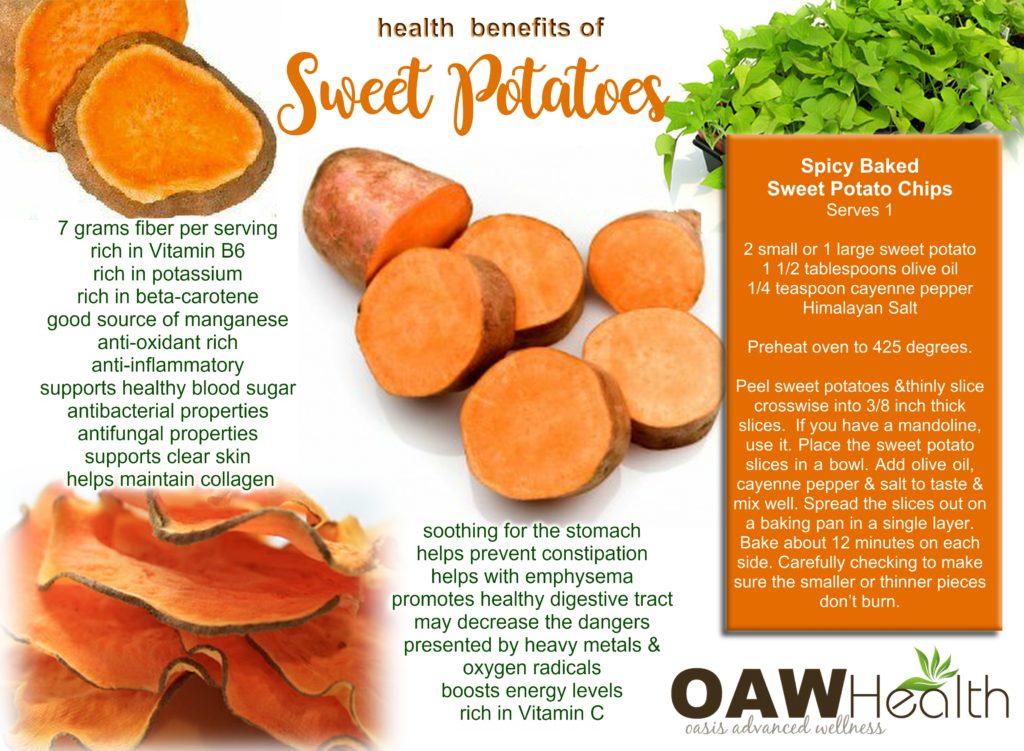Not only do sweet potatoes taste like a scrumptious dessert, they also provide your body with some incredible health benefits. Cutting-edge research on sweet potatoes indicates they have many unique nutritional benefits that support good health and well-being. Among these benefits are antioxidants, anti-inflammatory nutrients, and blood sugar-regulating nutrients.
For instance, in several studies from Africa, sweet potatoes were found to contain between 100 to 1,600 micrograms (RAE) of vitamin A in every 3.5 ounces—enough, on average, to meet 35% of all vitamin A needs, and in many cases sufficient to meet over 90% of vitamin A needs (from this single food alone).
Interesting Facts about Sweet Potatoes
Do you know some sweet potatoes can also be gorgeous purple?
Often, it’s difficult to tell from the sweet potato skin how rich the inside will be in purple tones. Scientists have now identified the exact genes in sweet potatoes (IbMYB1 and IbMYB2) that get activated to produce the purple anthocyanin pigments responsible for the rich purple tones of the flesh. The purple-fleshed sweet potato anthocyanins—primarily peonidins and cyanidins—have insignificant antioxidant and anti-inflammatory properties. Particularly when passing through our digestive tract, they may be able to lower the potential health risk posed by heavy metals and oxygen radicals.
Include some fat when consuming sweet potatoes if you enjoy the full beta-carotene benefits.
Recent research has shown that consuming a minimum of 3-5 grams of fat per meal significantly increases our uptake of beta-carotene from sweet potatoes. Of course, this minimal amount of fat is very easy to include. For instance, extra virgin olive oil, organic grass-fed butter, or coconut oil are great choices.
Steaming or boiling sweet potatoes may allow your body to get more excellent nutritional benefits from sweet potatoes.
Recent studies show excellent preservation of sweet potato anthocyanins with steaming, and several studies comparing boiling to roasting have shown better blood sugar effects (including the achievement of a lower glycemic index, or GI value) with boiling. Only two minutes of steaming sweet potatoes have been shown to deactivate peroxidase enzymes that might otherwise be able to break down anthocyanins found in the sweet potato. In fact, with these peroxidase enzymes deactivated, natural anthocyanin extracts from sweet potato used for food coloring may be even more stable than synthetic food colorings. This benefit isn’t limited to the food’s appearance since the anthocyanins have significant health benefits as antioxidants and anti-inflammatory nutrients.
Antioxidant properties.
Researchers have long been aware of sporamins—storage proteins in sweet potatoes—but only recently has research shown some of their unique antioxidant properties. The potential health benefits of the sweet potato sporamins in helping prevent oxidative damage to our cells is not surprising since sweet potatoes produce sporamins whenever subjected to physical damage to help promote healing.
Exciting Health Benefits of Sweet Potatoes
- 7 grams fiber per serving
- rich in Vitamin B6
- rich in potassium
- rich in beta-carotene
- good source of manganese
- antioxidant rich
- anti-inflammatory properties
- supports healthy blood sugar
- antibacterial properties
- antifungal properties
- supports clear skin
- helps maintain collagen
- soothing for the stomach
- helps prevent constipation
- helps with emphysema
- promotes a healthy digestive tract
- may decrease the dangers presented by heavy metals & oxygen radicals
- rich in Vitamin C
Difference Between Sweet Potatoes and Yams
It is very easy, especially in the United States, to confuse sweet potatoes and yams. However, they are completely different foods that belong to different plant families. The main difference is that sweet potatoes are much more available in the United States than are yams.
There are a couple of reasons for this confusion.
1) Shoppers are likely to find sweet potatoes and yams that look similar in terms of size, skin color, and flesh color.
2) Our government agencies have allowed the use of the terms “sweet potato” and “yams” somewhat interchangeably on labeling. In many stores, you may find bins labeled “Red Garnet Yams” and “Jewel Yams,” but the potatoes in these bins are actually sweet potatoes. Below are some general rules to follow.
- In most U.S. groceries, you should assume that you are always purchasing a sweet potato, even if the sign says “yams.” More than one million sweet potatoes are commercially grown in the United States every year, while commercial production of yams is rare.
- Don’t let the flesh color determine whether you are getting a sweet potato or a yam. Both root vegetables come in a variety of colors. You should always assume you are getting a sweet potato, regardless of flesh color.
- If you want to purchase a true yam (from the plant genus Dioscorea), visiting a more internationally focused store may be your best bet.
The name “yam” was adopted from “nyami“—the Fulani (West African) word that means “to eat” and that has traditionally been used to refer to yams. Yams are native to Africa and Asia, and unlike potatoes, they have the potential to grow to a larger size.
From a science perspective, true yam is a root vegetable belonging to the Dioscoreaceae family, which are monocotyledons (or “monocots” for short, with the prefix “mono” referring to the fact that they have only one embryonic seed leaf). Sweet potatoes belong to the Convolvulaceae or morning-glory plant family, are dicotyledons (or “dicots” for short, with the prefix “di” referring to the fact that they have two embryonic seed leaves), and are known by the scientific name of Ipomoea batatas. These two root vegetables come from very different parts of the plant world, even though their names are used interchangeably in the United States marketplace.
Spicy Baked Sweet Potato Chips Recipe
Serves 1
Ingredient List
2 small or 1 large sweet potato
1 1/2 tablespoons cold-pressed, extra virgin olive oil or avocado oil
1/4 teaspoon cayenne pepper
Himalayan Salt
Directions
Preheat the oven to 425 degrees. Peel the sweet potatoes and thinly slice crosswise into 3/8-inch thick slices. If you have a mandoline slicer, use it for consistent, even slices. Place the sweet potato slices in a bowl. Add olive oil or avocado oil, cayenne pepper, and salt to taste. Mix well. Spread the slices out on a baking pan in a single layer. Bake for about 12 minutes on each side. Check often to make sure the smaller or thinner pieces don’t burn.
References
- Ahmad MH, Morrison EY, Asemota HN. Food processing methods influence the glycaemic indices of some commonly eaten West Indian carbohydrate-rich foods. Br J Nutr. 2006 Sep;96(3):476-81. 2006.
- Bahado-Singh PS, Wheatley AO et al. Food processing methods influence the glycaemic indices of some commonly eaten West Indian carbohydrate-rich foods. Br J Nutr. 2006 Sep;96(3):476-81. 2006.
- Bengtsson A, Brackmann C, Enejder A et al. Effects of Thermal Processing on the in Vitro Bioaccessibility and Microstructure of ‘-Carotene in Orange-Fleshed Sweet Potato. J Agric Food Chem. 2010 Oct 1. [Epub ahead of print]. 2010.
- Chang WH, Huang YF, Yeh TS et al. Effect of purple sweet potato leaves consumption on exercise-induced oxidative stress, and IL-6 and HSP72 levels. J Appl Physiol. 2010 Sep 23. [Epub ahead of print]. 2010.
- Choi JH, Choi CY, Lee KJ et al. Hepatoprotective effects of an anthocyanin fraction from purple-fleshed sweet potato against acetaminophen-induced liver damage in mice. J Med Food. 2009 Apr;12(2):320-6. 2009.
- Failla ML, Thakkar SK and Kim JY. In vitro bioaccessibility of beta-carotene in orange fleshed sweet potato (Ipomoea batatas, Lam.). J Agric Food Chem. 2009 Nov 25;57(22):10922-7. 2009.
- Han KH, Matsumoto A, Shimada K et al. Effects of anthocyanin-rich purple potato flakes on antioxidant status in F344 rats fed a cholesterol-rich diet. Br J Nutr. 2007 Nov;98(5):914-21. Epub 2007 Jun 11. 2007.
- Hwang YP, Choi JH, Yun HJ et al. Anthocyanins from purple sweet potato attenuate dimethylnitrosamine-induced liver injury in rats by inducing Nrf2-mediated antioxidant enzymes and reducing COX-2 and iNOS expression. Food Chem Toxicol. 2010 Oct 8. [Epub ahead of print]. 2010.
- Low JW, Arimond M, Osman N et al. A food-based approach introducing orange-fleshed sweet potatoes increased vitamin A intake and serum retinol concentrations in young children in rural Mozambique. J Nutr. 2007 May;137(5):1320-7. 2007.
- Ludvik B, Hanefeld M, and Pacini G. Improved metabolic control by Ipomoea batatas (Caiapo) is associated with increased adiponectin and decreased fibrinogen levels in type 2 diabetic subjects. Diabetes Obes Metab. 2008 Jul;10(7):586-92. Epub 2007 Jul 21.
- Mei X, Mu TH and Han JJ. Composition and physicochemical properties of dietary fiber extracted from residues of 10 varieties of sweet potato by a sieving method. J Agric Food Chem. 2010 Jun 23;58(12):7305-10. 2010.
- Mills JP, Tumuhimbise GA, Jamil KM et al. Sweet potato beta-carotene bioefficacy is enhanced by dietary fat and not reduced by soluble fiber intake in Mongolian gerbils. J Nutr. 2009 Jan;139(1):44-50. Epub 2008 Dec 3. 2009.
- Noda N and Horiuchi Y. The resin glycosides from the sweet potato (Ipomoea batatas L. LAM.). Chem Pharm Bull (Tokyo). 2008 Nov;56(11):1607-10. 2008.
- Ozaki S, Oki N, Suzuki S et al. Structural Characterization and Hypoglycemic Effects of Arabinogalactan-Protein from the Tuberous Cortex of the White-Skinned Sweet Potato ( Ipomoea batatas L.). J Agric Food Chem. 2010 Oct 29. [Epub ahead of print]. 2010.
- Philpott M, Ferguson LR, Gould KS et al. Anthocyanidin-containing compounds occur in the periderm cell walls of the storage roots of sweet potato (Ipomoea batatas). J Plant Physiol. 2009 Jul 1;166(10):1112-7. Epub 2009 Feb 6. 2009.
- Tumuhimbise GA, Namutebi A and Muyonga JH. Microstructure and in vitro beta carotene bioaccessibility of heat processed orange fleshed sweet potato. Plant Foods Hum Nutr. 2009 Dec;64(4):312-8. 2009.
- Wang YJ, Zheng YL, Lu J et al. Purple sweet potato color suppresses lipopolysaccharide-induced acute inflammatory response in mouse brain. Neurochem Int. 2010 Feb;56(3):424-30. Epub 2009 Nov 24. 2010.
- Xie J, Han YT, Wang CB et al. Purple sweet potato pigments protect murine thymocytes from (60)Co gamma-ray-induced mitochondria-mediated apoptosis. Int J Radiat Biol. 2010 Aug 10. [Epub ahead of print]. 2010.
- Yin YQ, Huang XF, Kong LY et al. Three new pentasaccharide resin glycosides from the roots of sweet potato (Ipomoea batatas). Chem Pharm Bull (Tokyo). 2008 Dec;56(12):1670-4. 2008.
- Zhang ZF, Fan SH, Zheng YL et al. Purple sweet potato color attenuates oxidative stress and inflammatory response induced by d-galactose in mouse liver. Food Chem Toxicol. 2009 Feb;47(2):496-501. Epub 2008 Dec 13. 2009.
- The World’s Healthiest Foods. www.whfoods.org
†Results may vary. Information and statements made are for education purposes and are not intended to replace the advice of your doctor. Oasis Advanced Wellness/OAWHealth does not dispense medical advice, prescribe, or diagnose illness. The views and nutritional advice expressed by Oasis Advanced Wellness/OAWHealth are not intended to be a substitute for conventional medical service. If you have a severe medical condition or health concern, see your physician of choice.









